| Article ID | Journal | Published Year | Pages | File Type |
|---|---|---|---|---|
| 4136777 | Pathologie Biologie | 2007 | 6 Pages |
RésuméLe déficit congénital en antithrombine (AT) est l'anomalie de l'hémostase la plus thrombogène connue actuellement. Les déficits quantitatifs totaux sont létaux dès la vie intra-utérine. Cependant, des mutations portant sur le site de liaison de l'AT à l'héparine peuvent donner lieu à des déficits homozygotes qualitatifs dits de type HBS. Nous rapportons ici l'observation d'une jeune patiente de 18 ans faisant des thromboses veineuses des membres inférieurs à bascule. Le bilan de thrombophilie montre un taux effondré (11 %) de l'activité AT en présence d'héparine alors que l'activité AT progressive et le taux d'AT antigène sont normaux. Deux autres sœurs homozygotes, sont dépistées lors de l'étude familiale. L'étude moléculaire montre qu'il s'agit de la mutation Arg47-Cys, déjà rapportée dans la littérature chez des patients de différentes origines géographiques. La prise en charge de ces patients homozygotes de type HBS est comparable à celle des patients déficitaires de type I ; un traitement anticoagulant préventif au long cours est indispensable étant donné le haut risque de thromboses. Les concentrés d'antithrombine sont indiqués dans toutes les situations ou une héparinothérapie est indispensable.
Congenital antithrombin (AT) deficiency is the most thrombotic genetic abnormality of haemostasis. Total quantitative deficits are lethal as early as life intra-uterine. Only homozygous mutations concerning the heparin-binding site are compatible with life. We report here the case of an 18 years old patient with recurrent deep venous thrombosis of the inferior members. Haemostasis exploration shows a decreased AT activity (11%) in the presence of heparin while AT progressive activity and AT antigen are normal. Two other homozygous sisters are identified in this family study. Molecular study of AT gene show Arg47-Cys substitution, already reported in the literature with patients of different geographic origins. Treatment of patients with homozygous AT type HBS deficiency is similar that for patients with heterozygous AT deficiency; a continuous prophylactic anticoagulant treatment is always necessary and AT concentrates infusions are required in all situations needing curative heparin treatment.
